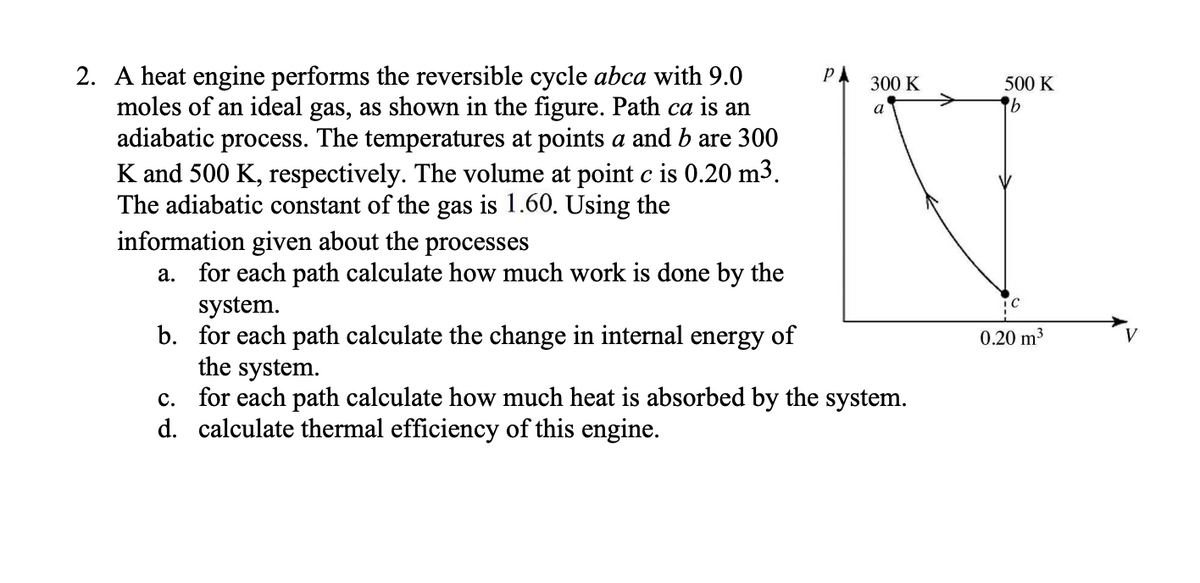A heat engine performs the reversible cycle abca with 9.0 moles of an ideal gas, as shown in the figure. Path ca is an adiabatic process. The temperatures at points a and b are 300 K and 500 K, respectively. The volume at point c is 0.20 m3. The adiabatic constant of the gas is 1.60. Using the information given about the processes a. for each path calculate how much work is done by the system. b. for each path calculate the change in internal energy of the system. c. for each path calculate how much heat is absorbed by the d. calculate thermal efficiency of this engine.
A heat engine performs the reversible cycle abca with 9.0 moles of an ideal gas, as shown in the figure. Path ca is an adiabatic process. The temperatures at points a and b are 300 K and 500 K, respectively. The volume at point c is 0.20 m3. The adiabatic constant of the gas is 1.60. Using the information given about the processes a. for each path calculate how much work is done by the system. b. for each path calculate the change in internal energy of the system. c. for each path calculate how much heat is absorbed by the d. calculate thermal efficiency of this engine.
Principles of Physics: A Calculus-Based Text
5th Edition
ISBN:9781133104261
Author:Raymond A. Serway, John W. Jewett
Publisher:Raymond A. Serway, John W. Jewett
Chapter18: Heat Engines, Entropy, And The Second Law Of Thermodynamics
Section: Chapter Questions
Problem 16P
Related questions
Question

Transcribed Image Text:2. A heat engine performs the reversible cycle abca with 9.0
moles of an ideal gas, as shown in the figure. Path ca is an
adiabatic process. The temperatures at points a and b are 300
K and 500 K, respectively. The volume at point c is 0.20 m3.
The adiabatic constant of the gas is 1.60. Using the
information given about the processes
a. for each path calculate how much work is done by the
PA
300 K
500 K
9,
a
system.
b. for each path calculate the change in internal energy of
the system.
c. for each path calculate how much heat is absorbed by the system.
d. calculate thermal efficiency of this engine.
0.20 m3
V
Expert Solution
This question has been solved!
Explore an expertly crafted, step-by-step solution for a thorough understanding of key concepts.
This is a popular solution!
Trending now
This is a popular solution!
Step by step
Solved in 7 steps

Knowledge Booster
Learn more about
Need a deep-dive on the concept behind this application? Look no further. Learn more about this topic, physics and related others by exploring similar questions and additional content below.Recommended textbooks for you

Principles of Physics: A Calculus-Based Text
Physics
ISBN:
9781133104261
Author:
Raymond A. Serway, John W. Jewett
Publisher:
Cengage Learning

Physics for Scientists and Engineers, Technology …
Physics
ISBN:
9781305116399
Author:
Raymond A. Serway, John W. Jewett
Publisher:
Cengage Learning

Physics for Scientists and Engineers: Foundations…
Physics
ISBN:
9781133939146
Author:
Katz, Debora M.
Publisher:
Cengage Learning

Principles of Physics: A Calculus-Based Text
Physics
ISBN:
9781133104261
Author:
Raymond A. Serway, John W. Jewett
Publisher:
Cengage Learning

Physics for Scientists and Engineers, Technology …
Physics
ISBN:
9781305116399
Author:
Raymond A. Serway, John W. Jewett
Publisher:
Cengage Learning

Physics for Scientists and Engineers: Foundations…
Physics
ISBN:
9781133939146
Author:
Katz, Debora M.
Publisher:
Cengage Learning

College Physics
Physics
ISBN:
9781938168000
Author:
Paul Peter Urone, Roger Hinrichs
Publisher:
OpenStax College

Physics for Scientists and Engineers
Physics
ISBN:
9781337553278
Author:
Raymond A. Serway, John W. Jewett
Publisher:
Cengage Learning

Physics for Scientists and Engineers with Modern …
Physics
ISBN:
9781337553292
Author:
Raymond A. Serway, John W. Jewett
Publisher:
Cengage Learning